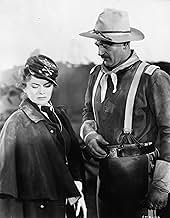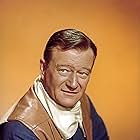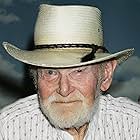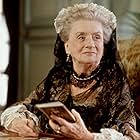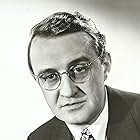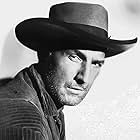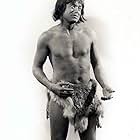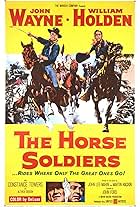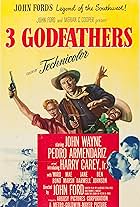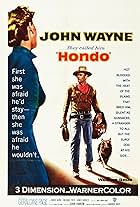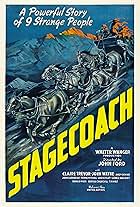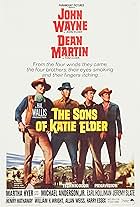Captain Nathan Brittles, on the eve of retirement, takes out a last patrol to stop an impending massive Indian attack. Encumbered by women who must be evacuated, Brittles finds his mission i... Read allCaptain Nathan Brittles, on the eve of retirement, takes out a last patrol to stop an impending massive Indian attack. Encumbered by women who must be evacuated, Brittles finds his mission imperiled.Captain Nathan Brittles, on the eve of retirement, takes out a last patrol to stop an impending massive Indian attack. Encumbered by women who must be evacuated, Brittles finds his mission imperiled.
- Won 1 Oscar
- 1 win & 1 nomination total
George Sky Eagle
- Chief Sky Eagle
- (as Chief Sky Eagle)
Rudy Bowman
- Pvt. John Smith - aka Rome Clay
- (uncredited)
Lee Bradley
- Interpreter
- (uncredited)
Storyline
Did you know
- TriviaJohn Wayne, who was 41 when the film was made, won great acclaim for his portrayal of 60-year-old Capt. Nathan Brittles.
- GoofsThe narration refers to the Battle of Little Bighorn, which took place in June of 1876. It also states that one of the ways the news of this was spread was via the Pony Express. The Pony express was founded in April of 1860 and ceased operations a year and a half later, in October of 1861. This was 15 years before the battle.
- Quotes
Captain Nathan Brittles: Never apologize. It's a sign of weakness.
- ConnectionsFeatured in The Siege at Red River (1954)
- SoundtracksShe Wore A Yellow Ribbon
(uncredited)
Heard over opening credits, in score and sung by troopers
Featured review
There is an ironic point about the production of SHE WORE A YELLOW RIBBON immediately after FORT APACHE. Most critics agree that Col. Owen Thursday, the martinet commander, is based on General George Armstrong Custer, and that the massacre of his command due to his own pig headedness is the battle of the Little Bighorn. But SHE WORE A YELLOW RIBBON begins with that moment in the summer of 1876 when the entire frontier was nervous after word came of the destruction of Custer forces. The historic continuity (which is amazingly consistent, despite minor anachronisms) is shown early when Captain Brittles, visiting his wife's grave, mentions to her the death of Captain Miles Keogh at the Little Bighorn. Historically this is correct. Keogh, a hero of the American Civil War, served with Custer's Seventh Cavalry and died with his commander and fellows. In fact, the only "survivor" of Custer's forces at that disaster was Keogh's horse, "Commanche".
Captain Brittles has served in the American cavalry for thirty years. He was one of those soldiers who held higher rank in the Civil War with a "Brevet", but in the cutbacks in the army following the war (Custer went from brevet major general to Lt. Col. in the regular army)Brittles had to be satisfied with the rank of Captain. His wife and children died (presumably of some epidemic illness at the post - they are buried nearby). His old orderly from the war, Quincannon (Victor McLaglen) is still serving him. But he is facing a crisis. His thirty years means retirement, unless the army decides to promote him to Colonel. Despite the debacle in Montana, it is not too likely that the politically unconnected Brittles will get the promotion his fine abilities deserve.
So we are watching an old soldier slowly fade away in this film. Brittles is aware he has days before he is to leave (unless a promotion turns up), and he has to try to keep the hot blooded Indian braves, impressed at what they just saw Crazy Horse and the Lakota forces accomplish, go on the warpath. He also has to keep his two most promising young officers (John Agar and Harry Carey Jr.) concentrating on their careers rather than fighting over Joanne Dru. He is worried too for Sgt. Quincannon, who is likewise going to be leaving the army a few days after Brittles. Will Quincannon's drunken, roistering ways ruin his chances to maintain his pension? And he has to keep an eye on the suspicious behavior of the local fort sutler (Paul Fix) is up to - can he be running guns? Whatever he faces, he faces unflinchingly, and his motto is never to apologize - it's a sign of weakness.
For all the anachronisms listed on this thread, such as the 48 star flag (in 1876?), Ford got the time and place perfect in what counts. Note the fascinating relationship of Brittles and Sgt. Tyree (Ben Johnson). 1876 was a crossroad year for the U.S. regarding the results of the Civil War. In the negative, a questionable Presidential election result was solidified when three southern states agreed to support the Republican (Rutherford Hayes) over the Democrat (Samuel Tilden) in return for the Federal troops being pulled out of the south and the official end of Reconstruction policies benefiting southern African-Americans. One can't deny that is still a stain in American history (despite Hayes excellent handling of the Presidency afterwords). But the former foes were finding less and less reason to dislike each other, and more and more to admire the grit both sides had shown. During the Civil War, Tyree was a Confederate Captain - he was Brittles' equal in rank. Once the war ended, after a few years, he joins the American Army and rises to the rank of Sergeant. Technically he is not as high a Sergeant as Quincannon, who is Brittles' aide. But Brittles constantly treats Tyree as a full equal, consulting him again and again on how to move next when going out of the fort to confront the Indian threat. The highpoint of this respect is when one of Tyree's "soldiers", "Trooper Smith" turns out to be a former Confederate cavalry leader named Rome Clay, and dies of wounds in an action against the Indians. Brittles and his men watch silently while Tyree and his fellow southern soldiers bury Clay properly with his flag, the Confederate one.
In terms of relations between the whites of the North and South, SHE WORE A YELLOW RIBBON is miles away from the confrontations of, say THE PRISONER OF SHARK ISLAND. There John Carridine's northern officer has nothing but fanatical contempt for Dr. Mudd, whom he considers evil for helping John Wilkes Booth. Until the end of that film, Carridine takes a sadistic interest in making Warner Baxter regret his every move. The events of THE PRISONER was from 1865 - 1869 (when Mudd finally returned to Maryland). This is seven years afterwords.
There are other little historical pointers. The rivalry of immigrant groups is shown when Quincannon is facing rival Sergeant Hochbauer, who openly dislikes the former as an overbearing Irishman (Hochbauer being a German). There is the civilian clothes that are meant for Brittles (complete with "Muller cut-down hat") that Quincannon ends sampling (which leads to his hysterically funny fight with Hochbauer and the other soldiers meant to take him to the guardhouse). Quincannon insists he is not out of uniform (technically he is) but is simply dressed as a retired gentleman should be. Yes, in 1876, that would be the dress of a retired gentleman.
I like this film. The characterizations of the all the actors are strong, and Ford had great set pieces in it. Perhaps not as great a film as THE SEARCHERS (which is more meaty and dark), but a top notch Western all the same.
Captain Brittles has served in the American cavalry for thirty years. He was one of those soldiers who held higher rank in the Civil War with a "Brevet", but in the cutbacks in the army following the war (Custer went from brevet major general to Lt. Col. in the regular army)Brittles had to be satisfied with the rank of Captain. His wife and children died (presumably of some epidemic illness at the post - they are buried nearby). His old orderly from the war, Quincannon (Victor McLaglen) is still serving him. But he is facing a crisis. His thirty years means retirement, unless the army decides to promote him to Colonel. Despite the debacle in Montana, it is not too likely that the politically unconnected Brittles will get the promotion his fine abilities deserve.
So we are watching an old soldier slowly fade away in this film. Brittles is aware he has days before he is to leave (unless a promotion turns up), and he has to try to keep the hot blooded Indian braves, impressed at what they just saw Crazy Horse and the Lakota forces accomplish, go on the warpath. He also has to keep his two most promising young officers (John Agar and Harry Carey Jr.) concentrating on their careers rather than fighting over Joanne Dru. He is worried too for Sgt. Quincannon, who is likewise going to be leaving the army a few days after Brittles. Will Quincannon's drunken, roistering ways ruin his chances to maintain his pension? And he has to keep an eye on the suspicious behavior of the local fort sutler (Paul Fix) is up to - can he be running guns? Whatever he faces, he faces unflinchingly, and his motto is never to apologize - it's a sign of weakness.
For all the anachronisms listed on this thread, such as the 48 star flag (in 1876?), Ford got the time and place perfect in what counts. Note the fascinating relationship of Brittles and Sgt. Tyree (Ben Johnson). 1876 was a crossroad year for the U.S. regarding the results of the Civil War. In the negative, a questionable Presidential election result was solidified when three southern states agreed to support the Republican (Rutherford Hayes) over the Democrat (Samuel Tilden) in return for the Federal troops being pulled out of the south and the official end of Reconstruction policies benefiting southern African-Americans. One can't deny that is still a stain in American history (despite Hayes excellent handling of the Presidency afterwords). But the former foes were finding less and less reason to dislike each other, and more and more to admire the grit both sides had shown. During the Civil War, Tyree was a Confederate Captain - he was Brittles' equal in rank. Once the war ended, after a few years, he joins the American Army and rises to the rank of Sergeant. Technically he is not as high a Sergeant as Quincannon, who is Brittles' aide. But Brittles constantly treats Tyree as a full equal, consulting him again and again on how to move next when going out of the fort to confront the Indian threat. The highpoint of this respect is when one of Tyree's "soldiers", "Trooper Smith" turns out to be a former Confederate cavalry leader named Rome Clay, and dies of wounds in an action against the Indians. Brittles and his men watch silently while Tyree and his fellow southern soldiers bury Clay properly with his flag, the Confederate one.
In terms of relations between the whites of the North and South, SHE WORE A YELLOW RIBBON is miles away from the confrontations of, say THE PRISONER OF SHARK ISLAND. There John Carridine's northern officer has nothing but fanatical contempt for Dr. Mudd, whom he considers evil for helping John Wilkes Booth. Until the end of that film, Carridine takes a sadistic interest in making Warner Baxter regret his every move. The events of THE PRISONER was from 1865 - 1869 (when Mudd finally returned to Maryland). This is seven years afterwords.
There are other little historical pointers. The rivalry of immigrant groups is shown when Quincannon is facing rival Sergeant Hochbauer, who openly dislikes the former as an overbearing Irishman (Hochbauer being a German). There is the civilian clothes that are meant for Brittles (complete with "Muller cut-down hat") that Quincannon ends sampling (which leads to his hysterically funny fight with Hochbauer and the other soldiers meant to take him to the guardhouse). Quincannon insists he is not out of uniform (technically he is) but is simply dressed as a retired gentleman should be. Yes, in 1876, that would be the dress of a retired gentleman.
I like this film. The characterizations of the all the actors are strong, and Ford had great set pieces in it. Perhaps not as great a film as THE SEARCHERS (which is more meaty and dark), but a top notch Western all the same.
- theowinthrop
- Aug 29, 2005
- Permalink
- How long is She Wore a Yellow Ribbon?Powered by Alexa
Details
- Release date
- Country of origin
- Languages
- Also known as
- La legión invencible
- Filming locations
- Goulding's Trading Post, Monument Valley, Utah, USA(was used as part of the army post)
- Production company
- See more company credits at IMDbPro
Box office
- Budget
- $1,600,000 (estimated)
- Runtime1 hour 44 minutes
- Aspect ratio
- 1.37 : 1
Contribute to this page
Suggest an edit or add missing content

Top Gap
By what name was She Wore a Yellow Ribbon (1949) officially released in India in English?
Answer






